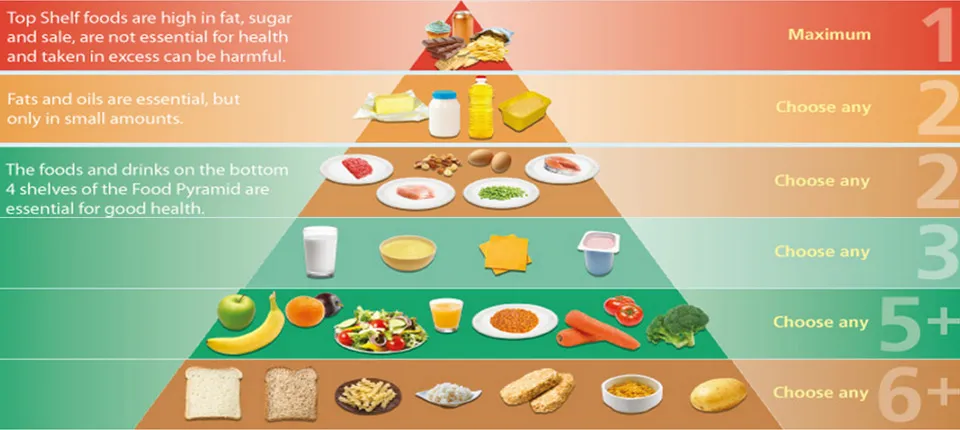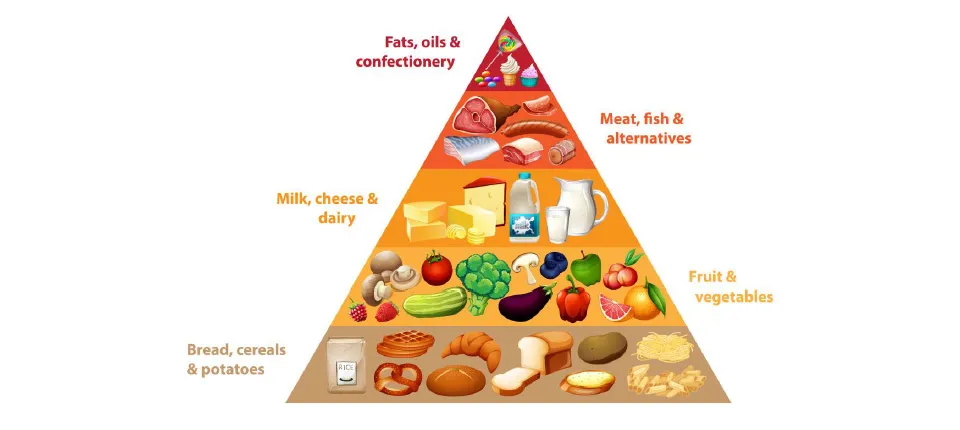
Food Pyramid for Kids & Teens: Key to Healthy Eating Habits
The Food Pyramid is a visual assortment of different foods and drinks that contribute towards a healthy balanced diet. It represents the optimal number of servings of healthy food for kids to be consumed from each of the basic food groups. The food pyramid for kids and adults is the same.
The food pyramid comprises 5 main food groups, namely; Grains, vegetables & fruits, dairy, meats & beans, oils, and sweets. This pyramid allows flexibility to choose foods and drinks from each food group depending on the preferences of an individual.
The first pyramid was published in Sweden in 1974. The United States Department of Agriculture (USDA) introduced a pyramid in 1992, called the "Food Guide Pyramid" or "Eating Right Pyramid". It was updated in 2005 to "MyPyramid", and then "MyPlate" replaced it in 2011.
What is the importance of the food pyramid for kids and teens?
The Food pyramid was chalked-out after in-depth research, keeping in mind the individual dietary habits and lifestyles of people. Hence, it is a very productive guide to nutrition and healthy food for kids. It helps massively by providing advice on foods, food groups, and dietary patterns (to provide the right and adequate amount of nutrients to kids) in order to promote overall health and prevent chronic diseases.The food pyramid for kids is an extremely helpful tool to inculcate healthy eating habits in them. Parents can use the food pyramid as a guide to developing a customized diet plan that meets the daily nutrition requirements of their child.
FOOD GROUPS IN THE FOOD PYRAMID FOR KIDS AND TEENS
The food pyramid divides foods and drinks into 5 main sections, beginning from the most important section at the bottom of the pyramid. Each food group has its own importance in a balanced diet chart. Let's help you explore these categories for a better understanding of healthy food for kids.
Let's help you explore these categories for a better understanding of healthy food for kids.1. Grains
The food pyramid begins with grains at the bottom. Grainy foods provide complex carbohydrates, forming a good source of energy and providing good nutrition when unrefined. Examples of these grainy foods include corn, wheat, pasta, rice, millet, muesli, quinoa, rye, barley, and oats.
➢ The largest chunk in your kid's plate should be whole grain foods.
➢ Fill your kid's plate with whole-wheat foods while replacing plain flour items. Whole-wheat flour helps in reducing the risk of ailments, as it is rich in fiber and vitamins like B-1, B-3, B-5, riboflavin, and folate.
Servings per day, as per age, for Boys
Food group |
9-13 years old |
14-18 years old |
Grains |
141- 255 grams |
170 – 283 grams |
Servings per day, as per age, for Girls
Food group |
9-13 years old |
14-18 years old |
Grains |
141- 198 grams |
170 – 226 grams |
2. Vegetables
The second aspect of the food pyramid is nutrient-rich veggies. Vegetables are stashed with many essential vitamins and minerals. Different vegetables contain different balances of micronutrients, so it is important to eat a wide variety of types.
Vegetables are very low in fats and calories and are a portion of perfectly healthy food for kids. They can be divided into the following categories:
✓ Starchy veggies - Examples of starchy vegetables include White potatoes, sweet potatoes, green peas, beets, corn, acorn squash, butternut squash, turnips, etc. Great source of fiber, vitamins, and minerals.
✓ Dark Greens - These are veggies rich in Vitamin A, Vitamin C, antioxidants, fiber, folate, vitamin K, magnesium, calcium, iron, and potassium. Five of the healthiest dark green vegetables include broccoli, kale, spinach, romaine lettuce, and Swiss chard. Other examples of dark greens include Bok choy, asparagus, artichoke, collard greens, and mustard greens.
✓ Red and Orange veggies - This variety includes carrots, sweet potatoes, pumpkins, tomatoes, winter squash, and various types of red peppers. High on vitamin K, vitamin A, vitamin C, fiber, and potassium.
✓ Beans and Peas - They are a great source of fiber, protein, and vitamin B. Examples include; Black beans, black-eyed peas, cannellini beans, chickpeas, kidney beans, soybeans, white beans, lima beans, pinto beans, fava beans, navy beans, edamame, mung beans, adzuki beans, cranberry beans.
✓ Other veggies – The other type of vegetables you could include in your kid's diet are parsnips, green beans, brussels sprouts, onions, cabbage, eggplant, green peppers, cauliflower, cucumbers, iceberg lettuce, bean sprouts, mushrooms, wax beans, okra, and zucchini.
Servings per day, as per age, for Boys
Food group |
9-13 years old |
14-18 years old |
Vegetables |
2-3.5 cups |
2-5.4 cups |
Servings per day, as per age, for Girls
Food group |
9-13 years old |
14-18 years old |
Vegetables |
1.5-3 cups |
2-5.3 cups |
3. Fruits
The third important shelf in this food pyramid for kids contains fruits. Fruits are low in calories and fat and are a source of natural sugars, fiber, and vitamins.
These include apples, oranges, grapes, bananas, strawberries, peaches, mango, etc. 1/4th of your kid's plate must contain fruits in it.
Top reasons for kids and teens to eat fruits daily:
✓ Very rich source of vitamins and minerals
✓ High on fiber and potassium
✓ Boosts the immune system
✓ Aids digestion
✓ Hydrates the body
✓ Keeps body weight in check
✓ Nourishes skin and hair
✓ Keeps cardiovascular diseases at bay
Servings per day, as per age, for Boys
Food group |
9-13 years old |
14-18 years old |
Fruits |
1.5-2 cups |
2-2.5 cups |
Servings per day, as per age, for Girls
Food group |
9-13 years old |
14-18 years old |
Fruits |
1.5-2 cups |
1.5-2 cups |
4. Dairy
Dairy makes the fourth position in the food pyramid for kids. Milk, yogurt, and cheese are the most commonly consumed forms of dairy.
✓ Milk and its derivatives are a highly rich source of dietary calcium and also provide protein, phosphorus, vitamin A, and vitamin D.
✓ Dairy is considered healthy food for kids, as it is beneficial for bone and teeth health.
✓ Milk derivatives with calcium content are considered dairy in the food pyramid for kids. Comparatively low-calcium products like cheese, cream, and butter are not seen as dairy in the food pyramid.
✓ On the other hand, fortified soymilk and other plant-based products with calcium are considered dairy in the food pyramid.
Servings per day, as per age, for Boys
Food group |
9-13 years old |
14-18 years old |
Dairy |
3 cups |
3 cups |
Servings per day, as per age, for Girls
Food group |
9-13 years old |
14-18 years old |
Dairy |
3 cups |
3 cups |
5. Meats & Beans
As we go up the ladder, Meats and their alternatives take the fifth spot in the pyramid. Meat is a major source of protein, iron, zinc, and vitamin B12. Meats, poultry, and fish include beef, chicken, pork, salmon, tuna, shrimp, and eggs.
The meat group is one of the major compacted food groups in the food pyramid for kids. Since, a wide variety of the same nutrients found in meat can also be found in foods like eggs, dry beans, nuts, soy, cheese, tofu, beans, lentils, chickpeas, and other high-protein vegetables, these meat alternatives are also included in this group.
Servings per day, as per age, for Boys
Food group |
9-13 years old |
14-18 years old |
Protein |
141-184 grams |
155-198 grams |
Servings per day, as per age, for Girls
Food group |
9-13 years old |
14-18 years old |
Protein |
113-170 grams |
141-184 grams |
6. Oils and sweets
A food pyramid's tip is the smallest part, so the fats and sweets at the top of the Food Pyramid for kids should comprise the smallest percentage of the diet. The foods at the top of the food pyramid should be eaten sparingly because they add extra calories, and provide negligible to no nutrition. These foods include salad dressings, oils, cream, butter, margarine, sugars, soft drinks, candies, and sweet desserts.
The focus here is to reduce the temptation in kids and teens to eat excessive junk food, fats, and sugars, as there is already enough fat and sugar in the rest of the diet.
HOW TO ENCOURAGE HEALTHY EATING HABITS IN KIDS?
Healthy habits go a long way and may tend to stick with your children till they grow old. Here are some effective ways to encourage healthy eating habits:✓ Eat together as a family and avoid screens during meals.
✓ Try new and interesting dishes to spice things up every now and then.
✓ Educate your kids about the health benefits of nutritional foods.
✓ Enjoy a variety of seasonal fruits and vegetable salads together.
✓ Allow your kids to help with grocery shopping and food preparation.
✓ Limit the junk food stock in the house.
Last but not the least; Limiting junk and sugary food is as important as serving healthy food for kids. 'Old habits die hard', a few tips to do the same might help.
✓ Always read labels for nutritional value while grocery shopping.
✓ Offer water when the child is thirsty, instead of sugary drinks.
✓ Use vegetable oils for cooking in place of butter or cooking margarine.
✓ Avoid cream, butter, or jams. Instead, use nut butter and avocado as spreads.
Nt. Divya Gandhi posted this article on https://www.tayyarijeetki.in/food-pyramid-for-kids-teens-key-to-healthy-eating-habits/